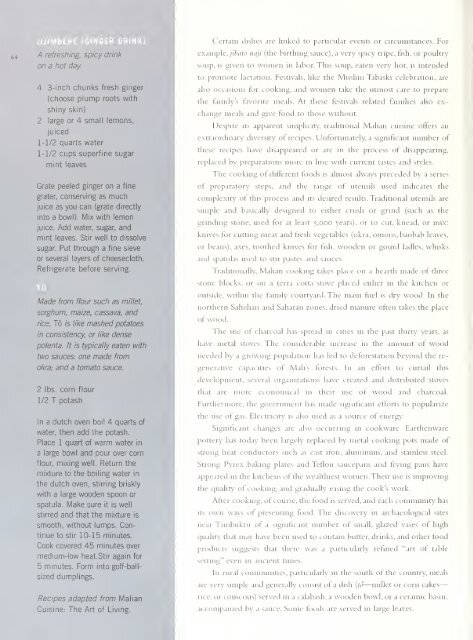SCOTLAND - Smithsonian Digital Repository - Smithsonian Institution
SCOTLAND - Smithsonian Digital Repository - Smithsonian Institution
SCOTLAND - Smithsonian Digital Repository - Smithsonian Institution
Create successful ePaper yourself
Turn your PDF publications into a flip-book with our unique Google optimized e-Paper software.
—<br />
Certain dishes are linked to particular events or circumstances. For<br />
A refreshing, spicy drink<br />
on a hot day.<br />
4 3-inch chunks fresh ginger<br />
(choose plump roots with<br />
shiny skin)<br />
2 large or 4 small lemons,<br />
juiced<br />
1-1/2 quarts water<br />
1-1/2 cups superfine sugar<br />
mint leaves<br />
Grate peeled ginger on a fine<br />
grater, conserving as much<br />
juice as you can (grate directly<br />
into a bowl).<br />
Mix with lemon<br />
juice. Add water, sugar, and<br />
mint leaves. Stir well to dissolve<br />
sugar. Put through a fine sieve<br />
or several layers of cheesecloth.<br />
example, /i7>i!/i)<br />
naji (the birthing sauce), a very spicy tripe, fish, or poultry<br />
soup, IS given to women in labor. This soup, eaten very hot, is intended<br />
to promote lactation. Festivals, like the Muslim Tabaski celebration, are<br />
also occasions for cooking, and women take the utmost care to prepare<br />
the family's favorite meals. At these festivals related families also exchange<br />
meals and give food to those without.<br />
Despite Its apparent simplicity, traditional Malian cuisine offers an<br />
extraordinary diversity ot recipes. Unfortunately, a significant number of<br />
these recipes have disappeared or are in the process of disappearing,<br />
replaced by preparations more in line with current tastes and styles.<br />
The cooking ot difterent foods is almost always preceded by a series<br />
ot preparatory steps, and the range of utensils used indicates the<br />
complexity of this process and its desired results. Traditional utensils are<br />
simple and basically designed to either crush or grind (such as the<br />
grinding stone, used for at least 5,000 years), or to cut, knead, or mix:<br />
knives for cutting meat and fresh vegetables (okra, onions, baobab leaves,<br />
or beans), axes, toothed knives for fish, wooden or gourd ladles, whisks<br />
and spatulas used to stir pastes and sauces.<br />
Refrigerate before serving.<br />
Traditionally, Malian cooking takes place on a<br />
hearth made of three<br />
stone blocks, or on a terra cotta stove placed either 111 the kitchen or<br />
Made from flour such as millet,<br />
sorghum, maize, cassava, and<br />
rice. To is like mashed potatoes<br />
in consistency, or like dense<br />
polenta. It is typically eaten with<br />
two sauces: one made from<br />
okra; and a tomato sauce.<br />
outside, within the family courtyard. The main fuel is dry wood. In the<br />
northern Sahelian and Saharan zones, dried manure often takes the place<br />
ot wood.<br />
The use of charcoal has spread m cities in the past thirty years, as<br />
have metal stoves. The considerable increase m the amount of wood<br />
needed by a growing population has led to deforestation beyond the regenerative<br />
capacities of Mali's forests. In an effort to curtail this<br />
development, several organizations have created and distributed stoves<br />
2 lbs. corn flour<br />
1/2 T potash<br />
In a dutch oven boil 4 quarts of<br />
water, then add the potash.<br />
Place 1 quart of warm water in<br />
a large bowl and pour over corn<br />
flour, mixing well. Return the<br />
mixture to the boiling water in<br />
the dutch oven, stirring briskly<br />
with a large wooden spoon or<br />
spatula. Make sure it is well<br />
stirred and that the mixture is<br />
smooth, without lumps. Continue<br />
to stir 10-15 minutes.<br />
Cook covered 45 minutes over<br />
medium-low heat. Stir again for<br />
5 minutes. Form into golf-ballsized<br />
dumplings.<br />
Recipes adapted from Ma Nan<br />
Cuisine: The Art of Living.<br />
that are more economical in their use ot wood and charcoal.<br />
Furthermore, the government has made significant efforts to popularize<br />
the use of gas. Electricity is also used as a source of energy.<br />
Significant changes are also occurring in cookware. Earthenware<br />
pottery has today been largely replaced by metal cooking pots made of<br />
strong heat conductors such as cast iron, aluminum, and stainless steel.<br />
Strong Pyrex baking plates and Teflon saucepans and frying pans have<br />
appeared in the kitchens of the wealthiest women. Their use is improving<br />
the equality of cooking, and gradually easing the cook's work.<br />
After cooking, of course, the fc~)od is served, and each community has<br />
Its own ways of presenting food. The discovery in archaeological sites<br />
near Timbuktu of a significant number of small, glazed vases of high<br />
cjuality that may have been used to contain butter, drinks, and other food<br />
products suggests that there was a particularly refined "art of table<br />
setting" even in ancient times.<br />
In rural cominunities, particularly in the south of the country, meals<br />
are very simple and generally consist of a dish {to—miUet or corn cakes<br />
rice, or couscous) served in a calabash, a wooden bowl, or a ceramic basin,<br />
accompanied by a sauce. Some foods are served in large leaves.
















